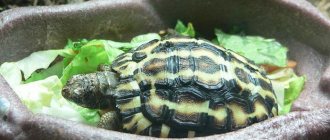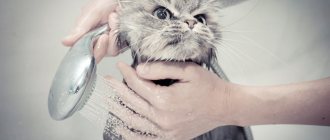Home › Terrariums and inhabitants ›
Your rating will be the first!
The red-eared turtle (lat. Chrysemys scripta elegans, formerly Trachemys scripta elegans) belongs to the family of freshwater turtles (Emydidae), it is a good strong swimmer. In the wild, red-eared turtles can be found basking on rocks, logs, and other surfaces that protrude above the water.
Turtles are cold-blooded reptiles, so they need external heat sources to stay warm. In the summer, in their natural habitat, they bask in the sun, and in the winter, they burrow into the ground to survive the cold period. To keep your red-eared turtle healthy, it requires three things: warmth, clean water and proper nutrition.
If you decide to have a red-eared slider as a child, the primary responsibility for care, cleanliness, feeding and treatment should remain with the adults, as proper care of these animals is more complex than most people realize.
Description
Red-eared turtle babies are about 2.5 cm in diameter, adults grow up to 30 cm in length. In the United States, the sale of turtles smaller than 10 cm in diameter is prohibited due to the risk of salmonellosis.
In a home aquarium, red-eared turtles usually reach sexual maturity at 2-4 years; in the wild, females mature at 5-7 years. Females are generally larger than males, although males have longer tails and very long front claws. The cloaca in females does not extend beyond the edge of the shell.
The red-eared slider has a red stripe behind each eye, which gives the species its name, although some may lack the red color. Some individuals may have red areas on the top of the head.
The red-eared turtle has webbed feet with strong claws. The shell of the hatchlings is green with a thin yellow-green or dark green pattern. As it matures, the shell may become yellow or olive green and may change color until it is a uniform dark olive green or greenish brown. Some males have black pigmentation and can be dark gray or black in color.
Breeders have developed two other color morphs (strains). One is pastel, a lighter colored turtle with varying amounts of red and yellow; the other is an albino - bright yellow, like a teenager. With age, these colors gradually disappear.
Average life expectancy is from 50 to 70 years.
Red-eared turtles quickly acclimatize to new conditions, although they may spend the first time hiding inside their shell. Over time, they will begin to associate the appearance of the owner with feeding and wait impatiently for you. If a red-eared slider feels threatened, just like other pets, it may bite.
You need to handle this pet carefully - if you pick it up, then pick it up with both hands. If the turtle is alarmed, it will struggle and may accidentally scratch its owner. Many turtles suffer serious, sometimes fatal, injuries when they fall, so you need to hold them tightly.
Always wash your hands after handling an animal. Children under 5 years old should not touch turtles, and older children should be explained how to handle them correctly and safely, and teach them to wash their hands after contact with a pet.
Selection and purchase of a red-eared turtle
In captivity, even with ideal care, turtles live up to 40 years. When choosing this type of amphibian, you must be completely sure that you will cope with the responsibilities and the animal will not become a burden to you. When choosing a water turtle, take into account all the nuances of its maintenance.
When purchasing, you need to choose a healthy individual, for this you need to take into account the following conditions:
- The size is at least 5 cm. This means that the turtle has already survived a difficult period in which most babies die;
- The integrity of the shell, its strength, without dents and tubercles, the presence of all claws and tail;
- When selected from an aquarium, the individual must be active, although if there is a suspicious movement, the turtles may hide and freeze; it must swim smoothly and not on one side;
- The eyes are shiny, the skin is without plaque, scratches, wounds, or white spots;
- The water in the aquarium should be of medium transparency, or preferably clean. Babies have a hard time with dirt and may have a fungal or bacterial infection that will be carried into your new aquarium.
Please note that an adult reaches its maximum size at 3 years of age.
This is 30 - 35 cm. Often, careless sellers, showing babies of five centimeters, pass them off as a dwarf.
Content
Aquarium
Red-eared sliders require housing that mimics their natural habitat: an aquarium with warm water for swimming and a dry, warm area to bask.
A home aquarium for a red-eared turtle can be made of glass or acrylic. Glass is better because acrylic tends to scratch easily. A plastic container, bathtub, or children's pool are also suitable. Remember that the turtle will grow, and depending on the size, the demands on housing increase. Adult red-eared turtles require an aquarium of at least 55 liters. To avoid housing problems in the future, you can immediately purchase a larger aquarium - the bigger the better.
For example, a red-eared turtle 10 cm long requires a volume of water for swimming (excluding land area and air space above the water, to prevent escape) of 70 liters, and a turtle 30 cm long needs 400 liters.
A home aquarium for a turtle should have an area of land where the reptile can go to bask, and a path along which it can climb there. For heating, driftwood, platforms made of smooth trees, glued to the wall of the aquarium, plastic, glass, other safe materials, with tree bark glued, smooth pebbles can be used to make it easier for the turtle to climb on them.
The aquarium should be covered with a lid to prevent possible escape. Avoid using plastic plants - turtles may try to eat them.
Warm
The temperature in the aquarium area should be approximately 24° C. If the temperature is lower than necessary, you can use a heater to maintain the desired water temperature and an infrared lamp. To maintain the temperature, you can use incandescent lamps (75 W or lower) with a reflector. The lamp is placed somewhere high above a dry area to keep the turtle warm. The air temperature in the heating area should be 29-32° C. The lamps must be firmly fixed so that they cannot fall into the water, and the turtle should not reach the lamp.
Light
If possible, ensure that your turtle aquarium is exposed to direct sunlight, but ensure that the temperature in the tank is not too high. Never place the aquarium outdoors in direct sunlight, as the temperature may be too high. If the indoor temperature is within the turtle's comfort zone, then it can be released for a walk outside. Make sure it cannot escape and that it is safe for small children, pets, and the turtle itself.
In order for your turtle to produce vitamin D-3, provide full-spectrum ultraviolet light (UVA and UVB) to the aquarium. Bulbs need to be replaced every 6 months as their ability to emit the full spectrum decreases over time. The light source should be at a distance of 45-60 cm from the red-eared slider. The light should be direct, shining directly on the turtle, and not passing through glass or plastic. A red-eared turtle aquarium should have a day/night light cycle.
Water
The water temperature in an aquarium with a red-eared slider should be 24-30° C. Remember that red-eared sliders are cold-blooded animals and their metabolism slows down at too low temperatures and they become inactive. It also affects their digestive system and can lead to serious health problems. The water temperature can be maintained using an immersed heater with a thermostat in the aquarium. The thermometer must be completely immersed in water; turn it off while removing water. The water temperature should be monitored daily.
Water quality is not critical to the health of the red-eared slider. However, uneaten food, urine, and excrement can contaminate the water, and it becomes a habitat for bacteria and other organisms, and this is harmful to the health of the turtle and is not very aesthetically pleasing, since it will create an odor in the aquarium. Therefore, the water in the aquarium needs to be changed regularly and the aquarium cleaned. Make sure that the clean water added to the aquarium after replacement is at the required temperature. In addition, to dechlorinate, settle the water or use dechlorinating conditioners.
The frequency of water changes depends mainly on whether you feed the turtles in the same aquarium or in a separate one, and whether the aquarium has a filtration system. If feeding occurs separately, the water usually needs weekly changes. To do this, a siphon is used to remove debris from the bottom of the tank, and usually 25-50% of the volume of water in the aquarium is changed. Every 1-2 months, depending on conditions, all the water in the aquarium is drained, the container is cleaned and refilled.
In order to remove debris from the aquarium and various chemicals, you can use aquarium filters. The choice of filter depends on the size of the aquarium and the turtle. These can be external or internal canister filters. Power mounted filters are often used. Using external filters can save turtles space in the aquarium. The more powerful the filter, the better.
Using aquarium plants in a turtle tank can help remove waste from the water, although the plants can also be eaten by turtles and produce more waste. You can try live plants with your red-eared turtles and see the results.
Techniques and techniques
It is easier to wash a red-eared turtle if it is in a good mood. A hungry pet will bite and resist. A tamed and calm reptile is easy to wash alone. If the turtle is not used to humans, an assistant may be needed.
Before swimming you need to prepare in advance:
- water supply;
- bathing container;
- thermometer;
- rags or soft sponge;
- towel.
If during the procedure you plan to clean the shell from algae or stubborn dirt, you need to add special products to the list.
After the water is prepared, the animal is placed in a basin. Wet the sponge with warm water and gently wipe the turtle's paws, tail and shell. If necessary, apply a little soap to it first. To remove detergent, the reptile should be thoroughly rinsed with clean water.
It is important to avoid positioning the reptile with the plastron facing up; this causes water and soap to get into the eyes, nostrils and mouth, and often causes active resistance.
That's right - after bathing, wipe the turtle dry with a towel, even if it goes to the aquarium afterwards. This is necessary so that detergents do not accidentally get into the water.
If the turtle retracts its head, you can try pouring a thin stream of water over the front of the shell. The method is only suitable if no soap was used. Typically reptiles will respond by extending their necks to allow them to rinse.
Feed and feeding
Juvenile red-eared sliders are primarily carnivorous, but they become increasingly omnivorous as they age. The diet should be balanced and include a variety of protein sources, both meat and fresh plant foods. Do not feed only commercial food. Juveniles should be fed daily, but adult turtles can be fed every other day. To feed red-eared turtles, it is better to place them in a separate container - this will reduce contamination of the aquarium with both food and feces. Give your pet about 15 minutes to eat before releasing it back into the aquarium.
- Commercial feeds should make up no more than 25% of a turtle's total diet. These should be high quality, low-fat products, floating pellets or sticks for fish, reptiles, turtles.
- Animal protein is less than 25% of the adult diet. Live fish food (sometimes), earthworms, finely chopped lean raw beef or beef heart, boiled chicken, snails, tubifex, large mealworms, mealworms, baby mice, crickets, bloodworms, shrimp, tadpoles, lean fish (excluding those , which may contain parasites, such as goldfish).
- Plant foods - 50% or more of the diet. Greens, dandelions, carrots (shredded), green beans, sweet potatoes, apples (grated), melon, berries, bananas, grapes, tomatoes, peaches, nectarines, aquatic aquarium or pond plants (duckweed, water hyacinth, water lettuce) .
- Nutritional supplements: multivitamins containing calcium, mineral supplements. Vitamins for turtles are given 2 times a week.
Your rating will be the first!
2767










